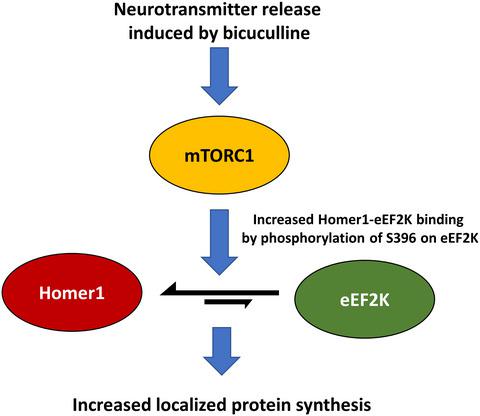当前位置:
X-MOL 学术
›
J. Neurochem.
›
论文详情
Our official English website, www.x-mol.net, welcomes your
feedback! (Note: you will need to create a separate account there.)
Bicuculline regulated protein synthesis is dependent on Homer1 and promotes its interaction with eEF2K through mTORC1-dependent phosphorylation
Journal of Neurochemistry ( IF 4.2 ) Pub Date : 2020-09-06 , DOI: 10.1111/jnc.15178 Luis F H Gladulich 1, 2 , Jianling Xie 2 , Kirk B Jensen 2 , Makoto Kamei 2, 3 , Roberto Paes-de-Carvalho 1, 4 , Marcelo Cossenza 1, 5 , Christopher G Proud 2
Journal of Neurochemistry ( IF 4.2 ) Pub Date : 2020-09-06 , DOI: 10.1111/jnc.15178 Luis F H Gladulich 1, 2 , Jianling Xie 2 , Kirk B Jensen 2 , Makoto Kamei 2, 3 , Roberto Paes-de-Carvalho 1, 4 , Marcelo Cossenza 1, 5 , Christopher G Proud 2
Affiliation

|
The regulation of protein synthesis is a vital and finely tuned process in cellular physiology. In neurons, this process is very precisely regulated, as which mRNAs undergo translation is highly dependent on context. One of the most prominent regulators of protein synthesis is the enzyme eukaryotic elongation factor kinase 2 (eEF2K) that regulates the elongation stage of protein synthesis. This kinase and its substrate, eukaryotic elongation factor 2 (eEF2) are important in processes such as neuronal development and synaptic plasticity. eEF2K is regulated by multiple mechanisms including Ca2+-ions and the mTORC1 signaling pathway, both of which play key roles in neurological processes such as learning and memory. In such settings, the localized control of protein synthesis is of crucial importance. In this work, we sought to investigate how the localization of eEF2K is controlled and the impact of this on protein synthesis in neuronal cells. In this study, we used both SH-SY5Y neuroblastoma cells and mouse cortical neurons, and pharmacologically and/or genetic approaches to modify eEF2K function. We show that eEF2K activity and localization can be regulated by its binding partner Homer1b/c, a scaffolding protein known for its participation in calcium-regulated signaling pathways. Furthermore, our results indicate that this interaction is regulated by the mTORC1 pathway, through a known phosphorylation site in eEF2K (S396), and that it affects rates of localized protein synthesis at synapses depending on the presence or absence of this scaffolding protein.
中文翻译:

双小分子调节的蛋白质合成依赖于Homer1,并通过依赖mTORC1的磷酸化促进其与eEF2K的相互作用
蛋白质合成的调控是细胞生理学中至关重要的且经过微调的过程。在神经元中,此过程受到非常精确的调节,因为哪些mRNA进行翻译高度依赖于上下文。蛋白质合成中最突出的调节剂之一是调节蛋白质合成延伸阶段的酶真核生物延伸因子激酶2(eEF2K)。该激酶及其底物,真核延伸因子2(eEF2)在诸如神经元发育和突触可塑性等过程中很重要。eEF2K受多种机制调控,包括Ca 2+离子和mTORC1信号通路,它们在神经系统过程(例如学习和记忆)中都起着关键作用。在这种情况下,蛋白质合成的局部控制至关重要。在这项工作中,我们试图研究如何控制eEF2K的定位及其对神经元细胞蛋白质合成的影响。在这项研究中,我们同时使用了SH-SY5Y神经母细胞瘤细胞和小鼠皮质神经元,并通过药理和/或遗传方法来修饰eEF2K功能。我们显示,eEF2K的活性和定位可以通过其结合伴侣Homer1b / c来调节,Homer1b / c是一种以参与钙调节信号通路而闻名的脚手架蛋白。此外,我们的结果表明,这种相互作用受eTOR2K中已知的磷酸化位点通过mTORC1途径调控(S396),
更新日期:2020-09-06
中文翻译:

双小分子调节的蛋白质合成依赖于Homer1,并通过依赖mTORC1的磷酸化促进其与eEF2K的相互作用
蛋白质合成的调控是细胞生理学中至关重要的且经过微调的过程。在神经元中,此过程受到非常精确的调节,因为哪些mRNA进行翻译高度依赖于上下文。蛋白质合成中最突出的调节剂之一是调节蛋白质合成延伸阶段的酶真核生物延伸因子激酶2(eEF2K)。该激酶及其底物,真核延伸因子2(eEF2)在诸如神经元发育和突触可塑性等过程中很重要。eEF2K受多种机制调控,包括Ca 2+离子和mTORC1信号通路,它们在神经系统过程(例如学习和记忆)中都起着关键作用。在这种情况下,蛋白质合成的局部控制至关重要。在这项工作中,我们试图研究如何控制eEF2K的定位及其对神经元细胞蛋白质合成的影响。在这项研究中,我们同时使用了SH-SY5Y神经母细胞瘤细胞和小鼠皮质神经元,并通过药理和/或遗传方法来修饰eEF2K功能。我们显示,eEF2K的活性和定位可以通过其结合伴侣Homer1b / c来调节,Homer1b / c是一种以参与钙调节信号通路而闻名的脚手架蛋白。此外,我们的结果表明,这种相互作用受eTOR2K中已知的磷酸化位点通过mTORC1途径调控(S396),











































 京公网安备 11010802027423号
京公网安备 11010802027423号